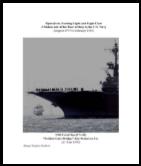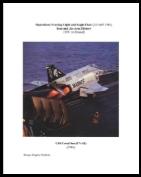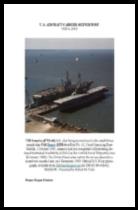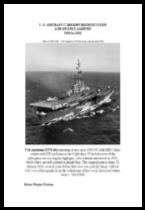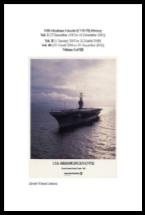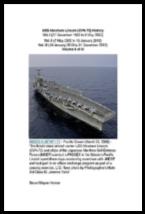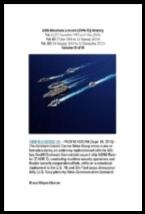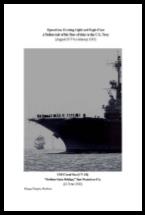






|
USS Midway (CVA-41) Fourth “WestPac”Operations Summary (15 February to 28 September 1961) CHAPTER XVIII Appendix IV |
|
Underway in the Pacific, possibly during the ship's third WestPac deployment, February 16-September 28, 1961. An A3D-2 Skywarrior of VAH-8 "Fireballers" is in the foreground. Photo by SM2 Robert Parrott, OS Division, USS Midway (CVA-41), 1959-1962 - NS024177 - Submitted by his son, John. http://www.navsource.org/archives/02/024177.jpg |

|
A Sailors tale of his Tour of duty in the U.S. Navy (August 1977 to February 1983) Operation Evening Light and Eagle Claw - 24 April 1980
Book - ISBN NO. 978-1-4276-0454-5 EBook - ISBN NO. 978-1-329-15473-5
Operations Evening Light and Eagle Claw (24 April 1980) Iran and Air Arm History (1941 to 1980)
Book ISBN NO. xxxxxxxxxxxxx EBook ISBN NO. 978-1-329-19945-3
U. S. AIRCRAFT CARRIER SHIP HISTORY (1920 to 2019)
Book - ISBN NO. 978-1-4276-0465-1 EBook - ISBN NO. 978-1-365-25019-4 Library of Congress Control Number: 2008901616 (Book Version)
U. S. AIRCRAFT CARRIERS REDESIGNATED AND OR RECLASSIFIED (1953 to 2016)
BOOK - ISBN NO. 978-1-4276-0452-1 EBook - ISBN NO. 978-1-365-25041-5 Library of Congress (Book Version) 2008901619
ENERGY QUEST AND U. S. AIRCRAFT CARRIER DEPLOYMENT HISTORY INVESTMENT CAPITAL REQUIRED TO PUBLISH 55 EIGHTH HUNNDRED PAGE BOOKS, EBOOKS & CD’s (48 Navy Books)
Book - ISBN NO. To Be Announced EBook - ISBN No. 978-1-365-26038-4
USS Abraham Lincoln (CVN-72) History Vol. I of III (27 December 1982 to 6 May 2003)
Book Vol. I of IV ISBN: TBA EBook Vol. I of IV ISBN: 978-1-365-73794-7
USS Abraham Lincoln (CVN-72) History Vol. II of III (7 May 2003 to 13 January 2010)
Book - ISBN NO. To Be Announced EBook - ISBN NO. 978-1-365-74027-5
USS Abraham Lincoln (CVN-72) History Vol. III of III (14 January 2010 to 31 December 2012)
Book - ISBN NO. To Be Announced EBook - ISBN No. 978-1-365-74145-6
USS Coral Sea CV-42 CVB-43 CVA-43 and CV-43 History and Those Aircraft Carriers Operating with Coral Sea During Her Tour of Service CONSTRUCTION to LAUNCHING and EARLY JET AIRCRAFT DEVELOPMENT (10 July 1944—2 April 1946) and a Tour of Duty in the U. S. Navy (August 1977 to February 1983)
ISBN: 9781434382917
|
|
USS Midway (CVA-41) Fourth “WestPac”Operations Summary (15 February to 28 September 1961) CHAPTER XVIII Appendix IV
OPERATIONS
CHRONOLOGY
15 February Departed Alameda 20-25 February NORM-ORI under COMFAIRHAWAII 26 February Departed Pearl Harbor 4 March CHOP to Seventh Fleet 6 – 7 March Guam 10 March Transited to San Bernardino Straits 14 – 16 March Exercise TOP HAT 20 – 23 March Hong Kong 24 – 26 March Operations, South China Sea 27 March Subic 28 March – 7 April Operations, South China Sea 8 April Subic 14 – 24 April Yokosuka 27 April – 7 May Operations, South China Sea 8 May Buckner Bay 15 – 20 May Kobe 22 May Exercise CHECKERTAIL 29 May – 3 June Iwakuni 9 –17 June Sasebo 20 – 23 June Exercise BIG SHOT 26 – 30 June Yokosuka 10 – 20 July Yokosuka 27 – 30 July Sasebo 30 July – 2 August Evading Typhoon Helen 2 – 4 August Sasebo 7 August Exercise CHECKERTAIL 9 – 10 August Sparrow Missile Shoot 19 Aug – 2 September Yokosuka 7 – 12 September Hong Kong 12 – 14 September Evading Typhoon Nancy 19 September CHOP to First Fleet 28 September Arrived Alameda
NAVIGATION DATA
MONTH NAVIGATION MILES STEAMED
February 6, 439 March 11,362 April 8,077 May 8,963 June 6,261 July 6,229 August 6,688 September 8,568
Total Miles 62,568
AIR OPERATIONS (15 February – 6 September)
At Sea Ashore Total 1. Days deployed 124 79 203
a. Without Air Operations 31 (In transit, weather, exercises, etc.) b. With Air Operations 93
Day Night Total 2. Flight Hours (CVG-2 only) 11,936 3,783 15,719
3. Carrier Landings (CVG-2 only) 4,505 1,036 5,541
Visual Actual Total 4. CCA Approaches (CVG-2 only) a. Day 2,280 82 2,2362 b. Night 1,525 29 1,554 c. Total 3,805 111 3,916
Flight Hours Carrier Landings 5. Air Operations other than CVG-2
a. MIDWAY TF 630.3 79 b. COD Aircraft 92 c. Marine Aircraft 509 d. VQ-1 16 e. Helicopter (1) Ashore 133.5 (2) At Sea 584.3 (3) Total 717.8
6. Accidents
DATE TYPE AIRCRAFT DESCRIPTION
27 March 1961 F8U Aircraft struck ramp on approach losing port main gear – pilot ejected – recovered safely 3 May 1961 A4D After cat shot aircraft hit water approximately 9,000 yards ahead of ship – pilot lost at sea. 3 June 1961 A4D Fire warning light – hydraulic failure aircraft caught fire and pilot ejected – recovered by destroyer. 30 June 1961 F3H Bingoed with low fuel state – aircraft porpoised on landing – pilot ejected during porpoise – fatal injury 25 July 1961 A4D Brakes failed and aircraft struck island and another Aircraft 7 August 1961 AD Engine failed on final approach – pilot initiated turn to miss ship and aircraft struck water directly astern of ship – pilot recovered by helo. 10 August 1961 F3H Multiple explosions after cat shot – fire warning light – pilot ejected and was recovered by helo. 11 August 1961 F4D Lost port main gear on ramp – aircraft engaged barricade – no injury.
OPERATIONS DEPARTMENT
1. General. The main difficulty encountered by the Operations Department was a critical shortage of personnel, trained or otherwise. Both communications divisions, OR and OS, and OI division were required to work on a port and starboard watch bill throughout the cruise. OC Division, during most of the cruise, had as many stations to man as there were men in the division. The solution to this problem is obvious.
2. OA Division
a. The problems experienced by the OA Division while in WESTPAC in 1961 are felt to be minor. There are, however, some improvements which, if made, would improve the efficiency of the weather service. They are listed below.
(1) The complement of eight Aerographers Mates should be increased to eleven men, or thirteen men if upper air soundings are to be made.
(2) The breakdown of men is as follows:
(a) One Chief to act as a forecaster. (b) Three sections with three men per section. This number of men per section is considered necessary to handle the heavy work load existing during air operations. (c) One police petty officer. (d) A two man upper air section if upper air soundings are desired. (e) An extra man to assume duties such as mess cook, compartment cleaner, etc.
(3) A “B” School graduate, not including the Chief, should be included in the allowance. This is necessary to insure that an experienced forecaster is available at all times in case of illness of one of the forecasters, and also to enable the forecasters to maintain a three section watch bill in-port rather than port and starboard duty which is now the case while operating in WESTPAC.
(4) One of the largest problems during the cruise was in communications. It is felt that another converter comparator bank is necessary. This will enable the personnel to copy two weather broadcasts at the same time, while comparing signals from both stations. This will insure a more complete coverage in all areas.
(5) The scale of the new Navy meteorological plotting charts is too small to insure an accurate analysis. A chart with the scale of the Air Force AWS-WPC 4-10-6 chart, or the old Navy 6803 chart is considered more desirable. The Air Force AWS-WPC 4-10-6 charts were made available to us by Fleet Weather Facility Yokosuka, Japan.
(6) A complete allowance of spare parts for the Radiosonde Recorder R-832A/SMQ-1 and the Facsimile Recorder, should be maintained aboard. This will eliminate delay in repairs. Due to the age of our present facsimile equipment there were continuous breakdowns resulting in loss of much needed information.
(7) We encountered some minor problems with supply, mainly in procuring the right size facsimile paper for our recorder. It is recommended that an allowance be made to the Fleet Weather Facility Yokosuke, Japan so they can maintain a stock of items such as facsimile paper, charts and forms to be made available to the Ships operating in WESTPAC.
3. O1
a. Communications
(1) The effectiveness of this ship and the Task Groups to which it was assigned was seriously reduced because of unreliable and inadequate Communications systems. Destroyers assigned that have not been modernized were restricted in communications to the extent that they were a liability rather an asset to AAW effectiveness. Their lack of reliability in control of aircraft adds to the burden of the carriers communication system, and personnel requirement because of the need for competent back up control. In addition it. is extremely frustrating and dangerous, for the pilots. As a result of having too little and some unreliable, communications equipment, the effectiveness of the.WF-2 aircraft is appreciably reduced. Middleman equipment on the WF-2 aircraft, which should be an important aid to AAW capability, was seldom utilized because of equipment failure.
(2) Recommendation: It is recommended that the AN/ARC 27 UHF equipment be approved for interim installation on all Destroyers that have not been modernized and for Carriers that have UHF communications limitations. Action should be taken at the proper command level to insure that satisfactory communication systems-are being designed for and installed in all units of the fleet.
b. Personnel.
(1) Comment: It is quite obvious that there has been a gradual deterioration of \the caliber of personnel assigned in the RD rate structure. It is also obvious that the present method of operating in the Fleet, the increasing complexity of equipments, the higher performance of ships aircraft and missiles dictates that more responsible, capable and better trained personnel be assigned this rate.
(2) During this cruise it was necessary for CIC personnel to stand watches on a port and starboard basis. In addition, they were required to maintain spaces and provide personnel to assist during replenishments. Expecting good alert performance, an effective training program and a good state of morale from personnel working on this basis is asking too much.
(3) Recommendations: It is recommended that all ships be directed to recruit the highest caliber of personnel to the RD rate. It is further recommended that all ships be manned in this critical rate at 100% of allowance. In addition, a more equitable sea-shore rotation policy should be established in this rate.
4. OR Division
a. The major problem that beset the Radio Division was the lack of qualified radio personnel. The turn over of radio personnel during the deployment was at its highest during peak traffic loads. OR Division ended the cruise 17 men below complement. It is recommended that all CVA’s be staffed prior to deployment with the BUPERS allowance of personnel, most of whom should remain aboard throughout the deployment.
5. OS Division
a. OS Division operated well below allowance during most of the cruise. Because of this shortage of personnel, the signal gang was on a continuous port and starboard watch bill including in-port periods.
b. Twelve inch mercury vapor search lights are not adequate for long range visual communications and are not effective for illuminating the Flight Deck or water in case of an aircraft accident or man overboard at night. It is recommended that 12 inch mercury vapor search lights be replaced by 24 inch carbon arc lights.
AIR DEPARTMENT
1. General.
a. The two major problems facing the Air Department for this entira cruise were the maintenance of proper personnel level readiness and a quite frugal allotment of operating – funds.
b. Contemporary air operations from attack carriers requires the actual maintenance of a level readiness stature. In particular Aircraft Handlers, rotating to shore duty, must either be relieved by qualified Aircraft Handlers or must be relieved with sufficient lead time to allow adequate and proper training. Assignment of untrained and/or not currently qualified personnel to carriers on the basis of •manning levels vice allowances (counting strikers as the equivalent of 3rd class), and delay of replacements two to three months after the predecessor's departure may add up to an acceptable arithmetic total but does not reflect realistic level readiness.
c. The restricted availability of OPTAR funds necessitated the procurement of many necessary; items on a crash basis. Initially a decided effort was made to procure catapult hardware, fuel hoses and nozzles, etc. on a programmed basis. Insufficient funds prevented full utilization of such a program. Assignment of OPTAR funds should reflect the ships operating schedule for a particular period, and also should recognize the inevitable usage of many items associated with air operations. A constructive program of replacement should also be incorporated for such items.
2. V-l Division
a. For V-l Division this cruiste was primarily a personnel training cruise. When MIDWAY departed CONUS in February this division had three operationally qualified aircraft directors assigned. The senior qualified director was a second class petty officer. The others were one third class and one airman. The situation existed until three additional operationally qualified men were received late in March. The division averaged about 89% manning level and at times dropped as low as 80%. This low manning level precluded the use of a split crew operation which is considered necessary to maintain peak operating efficiency for continuous air operations of more than 48 hours.
b. No unusual operational problems were encountered during the cruise.
c. The following aircraft were embarked during the cruise:
A3D-2. 9 F8U-2 14 F8U-1P 3 A4D 24 F3H-2 12 AD-6 12 AD-5Q 2 ' WF-2 3 TF-1 1 HUP-2 2 82
3. V-2 Division;
a. Catapult operations during the cruise were routine, no unusual maintenance or operational problems were encountered. The lack of maintenance difficulties, other than routine, is attributed to a good maintenance program as specified in current directives and to the excellent support given by WESTPAC CAFSU Rep's.
b. While not establishing new catapulting records, the MIDWAY enjoyed consistent and dependable catapult operations: Despite a 50% loss and/or change in personnel during the cruise coupled with an average 18% under, allowance problem, a consistent forty second or less launch interval was maintained. During periods of sustained catapult operations (24 hours) three catapult crews were made up by utilizing mess cooks and compartment cleaners. This emergency means of obtaining three full catapult crews was made possible by the two following procedures:
(1) By sending only those personnel mess cooking and compartment cleaning who are qualified on the job and who are good workers.
(2) By conducting and maintaining a training program to provide personnel well trained in as many jobs as operations permit.
c. The following items are considered worth mentioning:
(1) During the first in-port period in Yokosuka the "Blast Deflector Actuator Arms" on the center panels of the forward catapults were replaced by aluminum ones procured from the San Francisco Naval Shipyard. The installation of these arms has proved very successful in .eliminating the problem of broken studs which occurred previously, particularly during launches when afterburners were used.
(2) During catapult operations in the later portion the cruise a “Yard Socket", on the cable equalizer, cable pulled out on the number two catapult necessitating the re-reaving of the grab. A FUR was submitted.
(3) The catapult officer's control station has proven to be a. valuable asset. It has facilitated smoother operations while giving the catapult officer a readily accessible means of determining launch pressures required and obtained.
Total catapult launches this cruise are:
Starboard Catapult Port. Catapult Sponson Catapult
2,828 2,632 136
d. 6,431 arrested landings were made during the cruise. This includes one F4D barricade engagement. Throughout the period Broderick and Bascombe CDP's were used exclusively. In addition to allowing higher engaging speeds it was found that the average number of hits per pendant was increased by about 20.
e. During the 1960 yard period, manholes were cut in the deck of each engine room. These manholes simplified re-reaving considerably as they provided a means of leading purchase cable directly from the hangar deck to the engine rooms.
f. The polyurethane terminal impact pads surprised all by proving to be quite durable. Pads presently installed have been used for a year and are still in usable condition.
g.Fairlead sheaves and B & B CDP’s are difficult to obtain at times in WESTPAC. Recommend this be kept in mind during pre-deployment provisioning.
4. V-3 Division
a. A consistently heavy deck loading made it necessary to place an average of fifty aircraft in the hangar deck many times. In order to keep the crunch rate within reason it was necessary to continually emphasize the necessity for proceeding with care and deliberation. On occasion this appeared to slow down the hangar deck operations, but at no time did it interfere with execution of the air plan.
b. Although the V-3 Division was fortunate throughout the cruise in being fairly close to manning level strength, there was the usual shortage of trained and experienced rated men. This problem was met by the constant training of more outstanding non-rated men. This resolution was satisfactory, but on numerous occasions resulted in less than the desirable level of mature judgment.
c. Whenever possible, similar type aircraft were spotted in the same bay. In general F8Us were parked in Bay 1, A4Ds in 2, F3Hs plus and A3D (in check) in Bay.
3. The space available in Bay 4 was used for ‘dud’ storage. Normally, during recoveries, F8Us were dropped down elevator 1 while still turning up. This alleviated the flight deck parking situation on full recoveries. All of the alert aircraft, less the A3Ds, were parked in Bay 2, allowing easy and rapid access to Elevator 2.
d. A continuing problem during the cruise was hangar deck clutter. This situation was particularly gross in hangar bay 4. During one operating period, when no boats or vehicles were aboard, bay 4 was used for its designed purpose with gratifying results in aircraft and rolling stock maintenance. Aviators, representing a considerable number of years experience, marveled at the uncluttered and efficient appearance and operation in Bay 4 during this period. Continued emphasis and effort must be placed on eliminating the amount of hangar bay clutter and informing all departments and squadrons that the hangar deck is not a handy dandy warehouse for an assortment of boxes, pallets, assorted tools, and miscellaneous unidentifiable equipment.
5. V-4 Division
a. A total of 6,826,620 gallons of JP-5 and a total of 454,863 gallons 115/145 aviation gasoline was received from fleet 'oilers during 28 underway refuelings. The normal time along side the transferring AO was 1.8 hours. All transfers were made through one six-inch hose. A minimum of eight tanks were open at all times allowing the tanker to pump at maximum pressure resulting in a receiving rate of 150,000 to 210,000 gallons per hour. The transfer rate is limited primarily by the pumping capacity of the tanker and number of stowage tanks receiving fuel.
b. Fuel Quality Control.
No problems were encountered with fuel contamination in aircraft or fuel received from fleet oilers during this cruise. Laboratory tests of all fuel tested were within the limitations prescribed in COMNAVAIRPAC Instruction 9150.36 and NAVSHIPS 315012. The contaminated fuel detector, AEL MK III was received late in the cruise, but the short time it was used has indicated it to be a reliable instrument to ensure delivery of clean fuel.
c. Aviation Fuel Expended.
A total of 6,455,312 gallons of aviation fuel was issued to embarked aircraft during the period of 15 February 1961 to 18 September 1961 Including 432, 953 gallons of 115/145 aviation gasoline. The highest quantities issued during any 24 hour period were 126,938 gallons of JP-5 and 14,937 gallons of aviation gasoline. Daily usage for normal Air Operation was 80,000 gallons of JP-5 and 7,000 gallons of aviation gasoline.
d. Aviation Lube Oil Expenditure.
(1) A total of 13,712 gallons of Navy Symbol 1100 Aviation Lube Oil was issued, during the period 15 February 1961 to 18 September 1961, One replenishment of 4,000 gallons was necessary in the cruise to provide a safe reserve.
e. Equipment.
(1) Centrifugal Purifiers.
The purifier’s performance in providing fuel bas been outstanding. It is considered superior to any method of purification available to the operating forces. No major problems have been encountered. Two sets of friction clutch liners have been replaced. The average number of starts was 46 and average number of operating hours was 101.
(2) Aviation Gasoline Service Pump. •
Both service pumps required the shaft and bearing to be replaced after 23 hours of operation due to improper alignment. The shaft was allowed to whip causing excessive vibration. The shaft bearings and seals were replaced arid the electric motor was lowered -to be concentrically aligned with the pump shaft by use of a dial indicator.
f. Tanks
All tanks were inspected and washed down. Tanks were found to be in outstanding condition.
g. Defueling
Defueling JP-5 into .slack stowage via replenishment -riser as directed by COMAVAIRPAC letter 9150,ser/73/13066 of 8 December 1959 is not feasible because of the inaccessibility of the sponson fueling filling connections. As a result a great quantity of usable .JP-5 was defueled over the 'side. Installation of flight deck and hangar .decks connections in accordance with CVA Ship Alt No. 1567 would alleviate this problem. The JP-5 distribution piping under the sponson, starboard side forward, was damaged and punctured after the protective covering had been torn loose.. The ship laid to and emergency, repairs were accomplished by .use of a plastic repair kit ESN-4730-542-3362 patch until the section could be replaced by the Ship Repair Facility, Yokosuka.
h. Personnel
V-4 Division. allowance is 12 petty officers and 58 non-rated. The manning level was 90% during the cruise. This is considered inadequate to safely operate the system. It is recommended that an increase .of 3 petty officers and 12 non-rated be added to the present allowance.
6.- V-.6 Division
MIDWAY deployed. with 4 MD-l tow tractors, 11 MD-lA tow tractors, 3 portable air compressors, 4 hydraulic test stands, 6 Waukesha auxiliary power units, 5 NC-1A mobile electric power plants, 5 low-profile thirty-gallon liquid oxygen servicing trailers and 11 GTC-85 starting, units on board. Three low-profile 50 gallon liquid oxygen servicing trailers were received during the fourth month of the cruise, and replaced three of the thirty-gallon units.
a. Aircraft Towing Equipment.
(1) The condition -of the tractors when MIDWAY deployed was excellent. The only difficulty encountered in maintaining them in this condition was due to lack of trained personnel and some non-availability of spare parts. The area where V-6 was seriously hampered was its lack of diesel mechanics and its inability to perform hydromantic transmission repair. Driver education must be a continuing function to preclude unwarranted destruction of equipment.
(2) Daily inspections were conducted on all units prior to use and preventative maintenance checks were conducted at thirty day intervals. An average daily availability of 96% was maintained on these units.
b. Aircraft Servicing Equipment.
(1) Three Joy 515 HGP-4 portable air compressors were on board during the cruise. These units proved to be excellent for shipboard use. One was kept on the flight deck at all times while the other two remained on the hangar deck. Some difficulty was encountered in maintaining the clutch linkage assembly, but an availability of 90% was maintained on these three units.
(2) The four hydraulic test stands on board proved to be quite reliable. Spare parts were in good supply with -the exception .of the starter for the REDCO hydraulic test stand. V-6 was able to maintain an availability of 75% on these units.
(3) Auxiliary Power Units E-APU-5 were a different problem. These units are very well designed with the exception of the wheels. The unit appears to be too heavy for the type wheel installed, which are of the semi-pneumatic type. After a very short operating time these tires collapsed and at no time were replacement wheels available through the supply system. Larger diameter solid rubber tires would be far better for this item of support equipment. A daily availability of 75% was maintained on these units.
(4) The NC-1A Mobile Electric Power Plants assigned were incapable of doing the assigned task. These units are not capable of maintaining the frequency limitations; required on many of today’s aircraft and as a result they were relegated to refueling jet aircraft and for starting power on AD aircraft. Even in this limited role the problems of maintenance were considerable. The ignition system parts in supply were not for the type power plant ultimately assigned and A/C generators were difficult to obtain. An availability of 75% on the D.C. and 55% on the A.C. portions of these units was maintained
(5) The liquid oxygen handling equipment assigned MIDWAY operated at top efficiency. The ship deployed with five low-profile, thirty-gallon servicing trailers and three of these were replaced with low-profile fifty-gallon units during the cruise. Spare parts were readily available for the thirty-gallon units, and the only difficulty encountered with the fifty-gallon unit was a ruptured disc which was replaced on board. (See BUWEPS message DTG 202049Z July 1961 and USS MIDWAY message DTG 011014Z July 1961). The average daily availability was very close to 100%.
e. GTC-85 Jet Start Units,
(1) The eleven GTC-85 start units aboard were highly reliable. Prior to deployment two men were trained on these units at O & R Alameda and they, in turn, instructed personnel assigned as GTC-85 maintenance men. Although the two 0 & R trained men were transferred early in the cruise the training program had advanced sufficiently to enable the new men to adequately take over. (2) Despite our inability to receive the GTC engine analyzer cables which were ordered prior to deployment, an availability of 96% was maintained on these units. The Supply Department gave commendable support to these units.
d. Deck Edge Power
The deck edge source power was very reliable. A program of checking the motor-generator output was rigorously pursued, and apparently paid dividends. Cables however, are still a problem. D.C. repair kits were utilized to repair the D.C. cables and proved invaluable. Much trouble was encountered with A.C. cables. All cables were-checked daily and cleaned weekly, but the failure rate of A.C. cables still remained excessive.
e. Avionics.
(1) With a few exceptions, the MIDWAY Avionics Shops carried sufficient test equipment to meet the Air Group's needs. All equipment had been repaired and calibrated by 0 & R Alameda prior to deployment and the calibration and repair facilities at NAS Atsugi were utilized while in WESTPAC. Several items of test .equipment required calibration after return to the ship at NSD Yokosuka, but this is attributed more to the trip from Atsugi to Yokosuka than the workmanship of the calibration lab.
(2) MIDWAY was able to support the WF-2 aircraft in all respects with, the exception of the following area. The AN/APS-82 test bench was inoperative throughout the cruise due' primarily to our inability to receive the dummy load until very-late, in the deployment.
(3) The Ships Assist Conference held on board MIDWAY one month prior to deployment proved to be an invaluable aid. Also, the "tailored" inventory of Special Tools (Section QT) allowed MIDWAY to carry only required items and immensely simplified the stowage, handling and accountability of special tools. Both these services should be continued for all carriers deploying to WESTPAC.
f. Personnel.
There is at present no allowance for diesel engine mechanics in the V-6 Division. This hampers maintenance of the considerable number of diesel engines assigned to the Air Department. To properly maintain this equipment, this division should have at least two rated diesel engine mechanics assigned.
ENGINEERING DEPARTMENT
Engine Miles Steamed 61,080.3 miles
NSFO Expended for Propulsion and In-port Use 15,688,443 gallons
Water Distilled 29,303,515 gallons
Average Consumption (Water) Man/Day 27.5 gallons
Water Hours None
Percent Time Underway,. 67.9
1. The Engineering Department carried out its mission with no significant casualties or breakdowns in electrical or mechanical equipment. Water and LOX presented no problems. Both the evaporators and 02N2 plant produced an abundance of water and oxygen in quantity to meet all demands. Water was available to the Air Group throughout the cruise.
2. A good, practical, well supervised preventative maintenance program paid dividends and kept the electrical and machinery installations in a good state of readiness.
3. Maximum use of ships facilities to manufacture or improvise parts such as cylinder liners for H.P. Air Compressors and bearings for aircraft elevator rollers, kept down time to a minimum.
4. The assistance from repair facilities at Subic, Sasebo and Yokosuka was outstanding. Quality of work and co-operation was excellent.
5. Recommendations - Operating schedules permit more uninterrupted time for actual engineering and damage control exercises.
GUNNERY
1. Deck Functions.
a.. The greatest problem faced in the Deck Group during the 1961 deployment was a lack of personnel. Until the later stages of the deployment, the three deck divisions operated 30% below allowance. The maintenance of assigned spaces could only be accomplished by establishing "teams," and assigning these teams a large number of spaces. This was clearly not the most desirable condition, but the solution proved adequate for short periods of time.
b. Ship's Boats:
(1) MIDWAY deployed with one GIG, one 40 foot personnel boat, three 50 foot utility boats, and two 26 foot motor whaleboats. During periods when a flag was embarked, a barge was normally carried. With the exception of the, motor whale boats, all boats, were carried in Hangar Bay No. 4. It was necessary to use ship's boats in Sasebo, Kobe, Iwakuni, and Pearl Harbor to land the liberty parties. In addition boats were, used in Hong Kong and Okinawa for working purposes. Civilian ferries were used exclusively in Hong Kong and water taxies were chartered in Kobe.
(2) The studies currently being conducted on the feasibility of stowing boats on the sponson decks, if approved, may alleviate the problem of boat stowage and at the same time, may make the ship more self-sufficient in port through a possible greater allowance of boats. Since, the ship's aircraft crane must be used to lower all liberty boats into the water, sponson stowage of boats, coupled with installed lowering equipment, would also remove delays encountered in getting the boats into the water.
c. Underway Replenishment. MIDWAY conducted underway replenishments during the deployment as follows:
DAY' NIGHT' TOTAL
DD Refueling (STBD) 39 8 47 DD Refueling (PORT) 6 4. 10 AO Refueling 22 7 29 AF Replenishment 7 0 7 AE Replenishment 5" 2 7 AKS Replenishment 4 0 4 Total 82 21 104
DD Refueling. MIDWAY has only one fueling station to port, a "close-in method" rig. This accounts for the wide difference in the number of destroyers fueled to starboard from those to port. Requests for the installation of an additional fueling station on the port side have been disapproved because of funding considerations. In addition to fuel, manila hi-line stations were normally rigged both port and starboard, to the destroyers’ forward hi-line station. Due to a shortage of deck personnel, ordnance division personnel were used to man the hi-line.
2. Ordnance Functions.
a. 5"/54 Battery.
(1) MIDWAY experienced great difficulty in procuring VT (FCL) non-fragmentating projectiles after departing CONUS. This ammunition was not available at NAD, Oahu, and only very limited quantities were obtained throughout
(2) Three fuze setter pilot motors for the 5"/54 MK 39 MOD 0 mount failed while deployed, and replacements could not be procured by the WESTPAC Supply System. Considerable delay was experienced in acquiring these motors from NSC Oakland.
b. Fire, Control.
(1) The most serious problem faced by the Fox Division during the deployment was a lack of experienced personnel. In total, the division operated approximately 25% below allowance, and because the number of petty officers on board was 57% below allowance, key billets were necessarily filled by relatively inexperienced seamen. The division operated during most of the deployment without
(2) The three GFCS MK 56 directors had a total out-of-commission time of 98 director days or 14.4% of the total director days during deployment. The largest out-of-commission periods occurred in director 6 (25 days,) and director 7 (20 days).
(3) The two MK 37 Gun Fire Control Systems were never out of commission for any appreciable .length of time. This can be attributed in part to the concentration of the most experienced fire control technicians on these systems.
c. Ordnance Handling. The G Division operated during the entire deployment at about 75% of its allowance of 163 men. While individual evolutions were carried out with relative ease, the division did not have the capability of carrying out several functions simultaneously.
(1) During the deployment replacement parts for MIDWAY'S bomb trucks were either fabricated by the ship’s force or "cannibalized" from other trucks. Using these methods, it was possible to keep 23 of the 26 trucks on board in commission.
(2) It is strongly recommended that a spare parts allowance for Aero 33C bomb trucks be established for CVA’s, based upon the number of trucks on board. Also, it is felt that G Division personnel assigned to maintain these trucks should be trained in truck maintenance. This training could be accomplished at the Overhaul and Repair Section of the ship's home port.
d. Guided Missiles. During this deployment MIDWAY was equipped with Sidewinder, Sparrow III, and for the first time, Bullpup air launched guided missiles.
(1) Sparrow III.
(a) Operations - Sparrow III missiles were carried-on all operational and training flights conducted by F3H-equipped FITRON-21. The old problem of non-availability of upper-stage bomb elevators for use during missile delivery to the flight and hangar decks existed because these elevators were generally blocked by aircraft spotted on or in close proximity to the access hatches. As a result, the aircraft elevators were used as the prime method of progressing missiles to the flight deck.
(b) Maintenance - 250 Sparrow Ill's were allocated to MIDWAY for her deployment load, 75 AAM-N-6a’s and 175 AAM-N-6's. Two AN/DSM-32 test sets, installed immediately prior to deployment, were used for periodic testing. To date, 1,252 guidance and control section tests have been conducted and an overall failure rate of 34% has prevailed. A total of 910 hours has been accumulated on the two test sets, 494 hours on serial #18 and 416 hours on serial #17. DSM-32 failures have been well documented by this and other CVA's and have consisted mainly of hydraulic pump/unloader valve failures in the HD-350, hydraulic pumping unit and test stand cable failures, special purpose, CX-4617/DSM-32. It is presumed spares for these items will be provided, as all CVA's utilizing AN/DSM-32's appear to be plagued with the same failures. One qualified AQC and one qualified ATI were on board throughout the deployment. Their services were indispensable to the .proper maintenance of the DSM-32's.
(2) Sidewinder. Sidewinder missiles were normally carried on operational and training flights conducted by FITRON-24 utilizing F8U aircraft and by FITRON-21. The Sidewinder again demonstrated its utility, .characterized by, the ease with which it is handled by ship and squadron and long hours of trouble free operation. Five guidance and control sections are held inoperative because of gyro failures and one for a sheared umbilical.
(3) Bullpup.
(a) Operations – MIDWAY deployed with 135 ASM-N-7a missiles stowed fully assembled in two new Modular Stowage Magazines. Including ORI expenditures, 18 missiles were launched by ATTACK SQUADRON 22 utilizing A4D aircraft. Two ballistic shots were traced to a loose fuse holder in one aircraft. All other firings were highly successful
(b) Maintenance - The Modular Stowage Magazines proved highly satisfactory permitting rapid handling of missiles from the magazine direct to the aircraft. Overhead hoist and track problems developed and will be rectified during MIDWAY’s next yard period.
(4) Personnel. The average on-board personnel count was 24 as compared to an allowance of 35. Every effort was made prior to the deployment to build up to a minimum of 30 men. This figure is considered desirable, as routine house keeping tasks absorb a large number of available man hours. The addition of Bullpup to MIDWAY'S missile inventory and evolutions conducted during this deployment indicate the present level of 24 or 25 men should be increased to provide for simultaneous handling of Bullpup, Sidewinder, and Sparrow III. Immediate and sustained delivery of these missiles to a minimum of three squadrons will require additional personnel.
e. Explosive Ordnance Disposal. MIDWAY deployed with one EOD officer"(assigned to G Division) and two enlisted EOD men; They were utilized for the normal functions of weapons loading and air operations standby. No serious disposal problems were encountered. Nuclear-weapons fire fighting teams, trained by and under supervision of EOD personnel, were obtained from the Air, Administration and Gunnery Departments. For small evolutions a fire fighting crew from the G Division was found to be more flexible
f. Gunnery Competitive Exercises. A total of five firing exercises were conducted, including one Z-2-G COMPEX. Scheduling exercises was, as always, a problem, although some improvement in aircraft services was noted as compared with previous deployments.
3. Nuclear Weapons Section.
a. Material. There were two significant material failures. During the NORM the drive gear on a bridge crane failed, reducing the capability of the forward SASS spaces to 50% for 24 hours. The second and most dangerous, failure: occurred when one of the four hoisting cables of a bi-rail hoist parted while carrying a MK 7 weapon. The bi-rail hoist had been given the required load test only six months prior to .the incident by the San Francisco Naval Shipyard,
b. Logistics
(1) Replacement of RED fuzes by Commander, Service Force, U.S. Pacific Fleet was rapid. At no time was a weapon RED for the lack of major components.
(2) Items ordered from Code 750, Naval Supply Center, Oakland, took an average of six weeks to receive. Notable exceptions were:
(a) Cable assembly CF 1409 was ordered 12 December 1960, 5 March 1961, and 25 April 1961 as replacement items. The cable assembly was not available through any supply source' and finally had to be manufactured specifically for MIDWAY. Two cable assemblies were received 21 July 1961 after a MK 27 had been in a RED condition for three months.
(b) Mallory battery #302830, used in T-290, has bad a life of less than 20 hours in lieu of the specified life of 50 hours. As a result, there were never enough batteries on hand. It is recommended that deploying ships keep 30 batteries on board in lieu of the 18, allowed by the COSAL until such time as batteries manufactured subsequent to 1959 becomes available.
(c) PAC 1S radiac instruments were received January 1961. Yardney 4XLR5DC Silvercel batteries, used in the PAC 1S were ordered 1 February 1961. The batteries are still unavailable.
c. Safety Precautions. There are no criteria for the Quarterly Safety Inspection required by Commander, Seventh Fleet. Depending on the desires of the Chief Observer, the inspection has varied from the equilibrium of a Z8V exercise to a TSI with no weapon loading.
d. Weapons Handling.
(1) During the deployment a total of 94 weapons loads were conducted. Problems were encountered with breakdowns of numbers 1 and 2 bomb elevators from the forward SASS and with the Aero 33C bomb trucks (previously discussed). Main difficulties with the elevators were electrical, caused by sticking switches and grounds due to dampness.
(2) In July, the Weapons Loading Director's Station was moved from the Weapons Coordination Center to an area on the hangar deck near the quarterdeck. This resulted in greater ease of coordination of loading teams, Technical Monitors, sentries, and weapons handling teams during "loading" operations.
4. Marine Detachment
a. Landing Force. A pre-deployment field training period at NAD, Concord of five days brought the Ship's Landing Party to a highly trained status. Small unit tactics, field firing of all weapons, and mob and riot control were stressed in this period. Even with on-board training sessions, maintenance of any degree of training for the Landing Party subsequent to deployment was difficult. A field exercise scheduled for Okinawa was canceled because of a change to the ship's schedule. Use of the Fuji-McNair training area was denied due to diplomatic complications. Current Landing Party Rosters were published every sixty days because of the frequent changes.
b. Security
(1) The guard operated on a port and starboard basis both at sea and in port. Due to some relief in security commitments late in the cruise, a '"modified" port and starboard duty status was possible in port.
(2) External security of the ship was established in those foreign ports requiring it, by use of seaman sentries who had fired the M-1 for familiarization. External security functioned under the Sergeant of the guard, and all other functions, including training, were subordinated to it during the deployment.
c. Honor and Ceremonies. The Detachment participated in three formal ceremonies as Honor Guard: Change of Command for the Commanding Officer, U. S. S. MIDWAY, relief of COMCARDIV THREE by COMCARDIV ONE and retirement of Warrant Officer OLIVER, USN.
d. Training. The Detachment conducted frequent familiarization firing of both rifle and pistols at various ports of call. A training schedule was conducted both at sea and in port and a vigorous P. T. program was prosecuted. The Detachment fired the M-1 rifle, “B” Course for re-qualification in three increments in Yokosuka. This was necessitated by the lack of range facilities at the home port prior to deployment.
MEDICAL DEPARTMENT
1. General.
a. Medical Logistic support was excellent throughout the entire cruise in all ports. There were no special epidemiological problems to report for this WESTPAC cruise. Venereal disease constituted a serious medical problem. Every known device was employed to educate and indoctrinate the crew before and during the cruise. The moral and the practical aspects were used to attack this problem. The mechanical prophylaxis was emphasized and these could be purchased thru the ships stores afloat or at the exchanges. It was deemed advisable to maintain medical quarantine in each case of venereal disease for a minimum of 30 days following the completion of treatment or the cessation of signs of clinical symptoms. This quarantine period was well accepted by the crew with careful indoctrination that this period of quarantine was necessary for their own health and for public health reasons to prevent spread of disease to others. Surprise V.D. inspections were held periodically during this WESTPAC cruise, and approximately 4600 men in the crew were inspected. No new cases of venereal disease were disclosed in this fashion. This can be indicative as evidence that the men were reporting promptly to sick bay. The V.D. rate during this WESTPAC cruise was approximately 50 percent less than the previous cruise. It is this Medical Officer's opinion after deploying personally for two consecutive WESTPAC cruises aboard the same ship that the 30 days medical quarantine period resulted in more care by the individual crew member to avoid exposure, or at least more careful employment of mechanical prophylaxis and other precautions. The decreased V.D. rate aboard this ship may also be attributed to better public health control in the Far East. However, the public health preventative program was completely inadequate in Kobe. No penicillin or antibiotics were used orally as prophylaxis throughout this cruise
b. On the two weeks return trip to CONUS, the medical department made available blood Kahns on a voluntary basis. It was noted that this service was well received.
c. Several cases of vasectomies performed by Japanese physicians came to our attention.
MEDICAL TREATMENTS AND DISPOSITIONS
Average on Board Strength 3514 Personnel Reporting to Sick Call for Treatment 11752 Personnel Admitted to Sick List 324 Average Number of Days on Sick List 4.32 Personnel Transferred to Hospital 70 Deaths (Record Purposes Only) 1 Number of Injuries (Total) 253 (Major) 33 (Minor) 220 Completed Physical Examinations 742 Partial Physical Examinations 1242 Immunizations 4484 X-Ray Films Exposed 1303 Pharmacy Issues 5124 Laboratory 4008 Electrocardiograms 124
SURGICAL PROCEDURES
Total 547 Hernioplasties Inguinal 12 Herniorrhaphies Epigastric 2 Plastic 7 Mastectomies 3 Pilonidal Cystectomies 7 Hemorrhoidectomies 2 Circumcisions- 46 Excision Hyorccele Rt. and Orchiectoray Rt- 1 Tendon Repairs - 3 Traumatic Amputations 3 Ganglion Removals 15 Cyst Removals- . 76 Suturing 316 Appendectomy 0 Excision Bone Chips, Knee- l Excision Bone Chips, Elbow 1 Mole and Wart Removal 52
VENEREAL DISEASE STATISTICS BREAKDOWN BY PORT CASES/IN- PORT DAYS GC NSU CHANCROID SYPHILS TOTAL PORT DAY
Hong Kong 8 12 16 0 -0- 28 3.50 Cubi Point 2 3 2 0 0 5 2.50 Yokosuka 38 72 67 2 2 l43 3.76 Kobe •: 5 50 24 5 1 80 16.00 Iwakuni . 5 11 14 0 0 25 5.00 Sasebo . 13 21 12 1 _ 0 _ 34 2.61 TOTALS 71 169 135 ~ 8 3 315 4.44
NOTE: The above figures include one patient who had both Gonorrhea and Chancroid and one patient who had both Chancroid and Syphilis.
VENEREAL. DISEASE. STATISTIC COMPARISON TOTAL GC NSU CHANCROID LYMPHOGRANULOMA VENEREAL SYPHILIS
59-60
Cruise 711 359 340 3 2 7
61
Cruise 315 169 135 8 0 3
DENTAL DEPARTMENT
1. The Dental Department in USS MIDWAY consists of four dental officers and eight enlisted men.
2. Two dental officers are assigned to full time operative dentistry, while two devote their time to sick call, prosthetics, .oral surgery, periodontia, oral prophylaxis and some operative procedures.
3. The eight enlisted men in the department consist of four general dental technicians, two prosthetic technicians and two strikers. Two senior general technicians are assigned duties in the clerical office, performing functions in property and accounting, supervision, and clerical procedures, including central control of appointments. The remaining general technicians perform oral prophylaxis, oral X-ray procedures, and assist the dental officers. The prosthetic technicians devote their full time to prosthetics. Two strikers are utilized as dental operating room assistants. The striker program has proven successful and has increased the efficiency of the department.
4. In addition to specific dental duties, all personnel are assigned to the ship eight battle dressing stations. They supplement medical department personnel in first aid training and practice.
5. Appointments for routine patients are distributed from a waiting list, and patients with emergency situations are treated immediately. Appointments are distributed proportionately to the ships company, air group and flag, when embarked.
6. The following is a statistical summary of the dental procedures rendered during a six month period of the 1961 cruise.
Restorations 2204 \Prosthetic Cases- 262 Tooth Removal 876 Prophylaxis 306 Gingivitis Treatment 184 X-Rays 2756 Gingivectomy- 88 Total Patients Treated 4010 Total Procedures 12466
7. The dental spaces have proven adequate.
SUPPLY DEPARTMENT
1. No unusual or insurmountable supply problems were encountered during this deployment. Delays in receipt of aviation supplies are indicated in the tables below.
a. From 15 February 1961 till 2 September 196l, MIDWAY'S AOCP/ANFE figures were as follows:
NR ITEMS SECT B ITEMS AVER NO. DAYS A/C AOCP ANFE AOCP ANFE AOCP ANFE
A3D-2 44 213 8 13 7 8 A4D-2 74 178 17 13 7 13 AD-7 3 30 3 5 10 12 F3H-2 52 137 25 2 8 10 F8U-2 46 19 15 0 7 12 HUP-3 2 1 2 0 15 9 WF-2 7 23 6 2 10 11 TF-1 0 3 0 0 0 11 F8U-1P 0 2 0 0 0 14 TOTALS 228 606 76 35 9 11
b. The number of times each individual item was requested on an AOCP basis was as follows:
NUMBER OF TIMES REQUESTED
A/C 1 2 3 4 5 6 7 A3D-2 41 2 A4D-2 38 6 3 1 1 AD-7 3 F3H-2 34 5 1 1 F8U-2 28 2 2 2 HUP-3 2 WF-2 5 1 TF-1 F8U-1P
2. Ship's stores sales exceeded one-half million dollars during the cruise. This included $166,000 of foreign merchandise special orders — $50,000 in the final order period when 2,300 orders were placed — and 750,000 cold drinks valued at $38,000.
|
